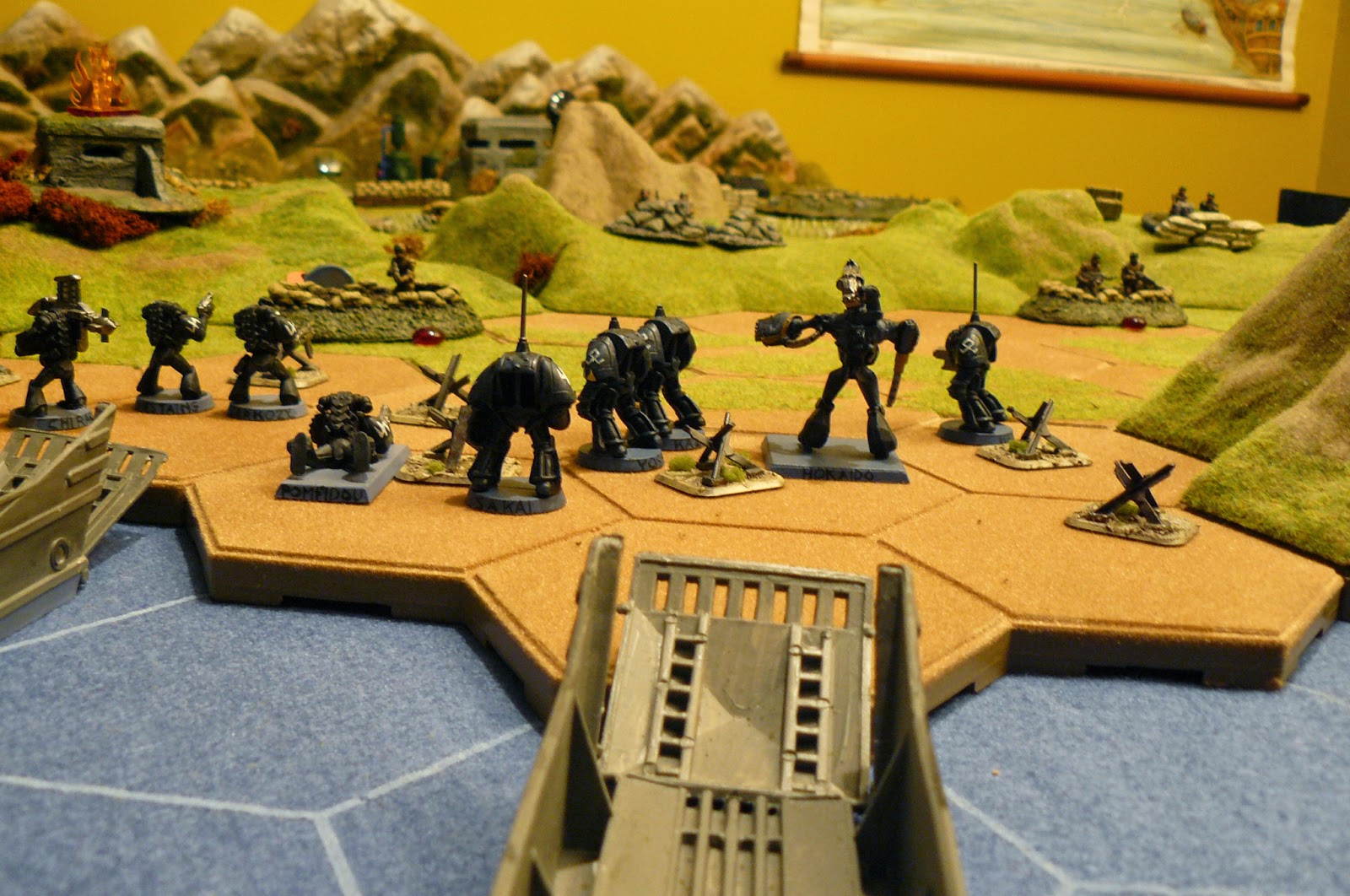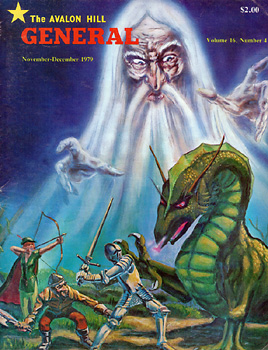When rummaging through my old gaming directories, I bumped in the game that served as the inaugural game at my previous house. The Siege of Lowenheim was organized in January 2006, and was a multiplayer game loosely based on a scenario that once appeared in Wargames Illustrated. The original was based on the Siege of the Peking legations during the Boxer rebellion, but I transformed it into a fantasy setting. The result was - judging by the comments made back then - an enjoyable game
 |
| Overview of the gaming table |
We had 2 previous blogposts about this game, so please read them (or look at the pictures!) to get an idea of what the game was about.
I also found in my directories the following pictures, which I made as a sort of prequel to the game. They were send to the various players to set the tone for the scenario. I do remember using an online tool to produce these tapestry of Bayeux posters.
The idea of these little pre-story was to set the mood: a city was under siege, all sorts of people came to help, but the real enemy would come from within the city. This was supposed to make the players wary about betrayal, but it was about ratmen trying to invade the city through the sewer system.
I also wrote a little article about this game for the magazine of Tin Soldiers Antwerp. The text is below, written in Dutch.
Sinds enige jaren ben ik steeds op
zoek naar originele invalshoeken om interessante games op tafel te brengen. De
klassieke benadering waarbij twee legers van gelijke puntenaantallen het tegen
elkaar opnemen is immers niet meer aan mij besteed, alhoewel er periodes
geweest zijn waarbij ik stevig aan dit concept vasthield. De Belegering van
Lowenheim, een spel voor 6 spelers dat ik afgelopen januari op mijn
wargaming zolder organizeerde, kadert in een reeks spelen die ik regelmatig op
touw zet, en waarbij spelers ongewone situaties voorgeschoteld krijgen. Dit
artikel geeft een beetje inzicht in hoe dit spel tot stand kwam.
De inspiratie voor Lowenheim
kwam uit een oud nummer van Wargames Illustrated, waarin een artikel
stond met als titel ‘55 minutes in
Peking’. Het is een spel dat de belegering van de legaties in Peking
tijdens de Boxer-oorlog weergeeft. Wegens de originele ideeën die erin vervat
zijn, is het heel wat keren herhaald in allerlei hobbyclubs en op conventies, zoals
een zoekopdracht via Google je snel leert.
De 8 spelers, die elk één van de
vreemde mogendheden (Groot-Britannië, USA, Italië, Frankrijk, Japan, Rusland,
Duitsland, Oostenrijk) in Peking controleren moeten hun legaties verdedigen
tegen de Boxers die overal in de stad opduiken. De spelers moeten hierbij
gebruik maken van resource cards, die hen elke beurt uitgedeeld worden.
Met deze kaarten kunnen ze aanvallen, branden blussen, gewonden genezen of
barricades opwerpen. Het is toegelaten om deze kaarten onderling te ruilen,
maar zoals je wel kan verwachten zijn deze resource
cards eerder schaars, wat tot gespannen situaties leidt. De activiteit van
de Boxers wordt uiteraard voorgesteld door figuren op de tafel, maar tevens
door random kaarten die bombardementen, tunnels of voedseltekorten simuleren.
Ik zal niet in detail ingaan op het specifieke spelsysteem, de geïnteresseerden
kunnen steeds Wargames Illustrated 27 er op na slaan.
Ik liep al geruime tijd met het idee
rond om ‘55 minutes in Peking’ zelf
eens te organiseren, maar wegens gebrek aan juiste figuren en scenery werd dit
steeds op de lange baan geschoven, totdat ik realiseerde dat een gelijkaardig
idee ook zou kunnen in een andere setting. Vermits ik over een vrij uitgebreide
collectie fantasy-figuren beschik, besloot ik om een fantasy-stad, Lowenheim,
als decor voor het spel te gebruiken. De verschillende spelers zouden hierbij
verschillende aanwezige troepenmachten in de stad controleren, die weliswaar
allen samen de stad moeten beschermen tegen indringers, maar tevens elk hun
agenda hebben om hun eigen belangen veilig te stellen.
Vermits het aantal figuren per
speler eerder klein zou zijn, had ik redelijk wat vrijheid om te kiezen welk
soort manschappen de stad zouden bemannen. Ook wou ik een beetje afstappen van
het typische fantasy-beeld dat Games Workshop ons voorschotelt, en wat
meer frivole en exotische types in het spel brengen. Tevens zouden elk van deze
groepen eigen objectieven in het spel hebben, die met elkaar conflicteren. Na
wat nadenken en experimenteren, kwam ik tot de volgende groepen:
- De
stadswacht onder leiding van kapitein Johann Mannheim, wiens voornaamste taak
erin bestond om de defensie van de stad te coördineren.
- De
Paleiswacht, aangevoerd door Ridder Sigisbiduwald von Trappstein-Hohenschlieffen,
die weliswaar over competente elite-ridders beschikte, maar zelf zich meer
zorgen maakte of hij wel op tijd zou wegraken uit de ruïnes van de stad.
- De
Elvenwacht van de Koningin, onder leiding van Alavandrel Vanmaris, die gezworen
had om de koningin van de stad te beschermen.
- De
ambassadeur van Bretonnia, kardinaal Jean-Jacques Descartes des Bois du
Loups-Garou, met zijn persoonlijke lijfwacht Les Cinq Mousquetaires. De kardinaal heeft wel een probleem;
hij is een weerwolf, en moet dit ten allen prijze geheimhouden.
- Severus
Arrhenius, Aartsmagiër van Lowenheim, Bewaker van het Boek van Malachias,
Houder van het Zegel van de Zeven Serpenten, en Beschermer van de Mystieke
Vuurvliegen is de oudste magiër van de Raad der Tovenaars. In in hun toren
hebben ze allerlei vreemde magische objecten ter beschikking, maar willen hun
kennis uiteraard niet zomaar delen met iedereen.
- Ambassadeur
Wen Jiao-Bao van Cathay, die met zijn Tijgergarde van de Blauwe Lotus vooral
interesse heeft in het bewaken van het Zilver Haar der Heilige Wind, waarmee
hij een krachtige windgeest zou kunnen oproepen.
Zoals je ziet komt er redelijk wat
inspiratie uit de meer klassieke fantasy-games, maar met genoeg originele
elementen om het geheel fris en origineel te maken. Eén van de reden waarom ik
dergelijke niet-alledaagse combinaties van troepen op de tafel zet is niet
alleen omdat ik de figuren heb, maar ook omdat het de spelers visueel iets
nieuws geeft. Dat geldt trouwens in het algemeen voor een visuele hobby als wargaming.
Het kan volstaan om een aantal visuele aspecten van een spel te wijzigen om het
er nieuw en origineel te laten uitzien. Het gebruik van grappige namen en hier
en daar een onnozel cliché of inside-joke geeft uiteraard ook wat extra sfeer.
De Boxers werden vervangen door
Skaven die, geheel passend met het beeld dat velen van de Skaven hebben,
tijdens het verloop van het spel de stad infiltreren via een onderaards stelsel
van gangen en riolen. Dit element zorgt ervoor dat de spelers steeds op hun
hoede moeten zijn, en dat de spelmeester troepen kom laten opduiken waar er
weinig actie op de tafel was. Bij dit type spel is de verhaallijn die
ontwikkeld wordt tijdens het spel immers van groter belang dan een ‘eerlijk’
verloop waarbij elke speler evenveel kans heeft om te ‘winnen’.
De speltafel zelf geeft een deel van
de stad weer, en is voornamelijk opgebouwd uit kartonnen huisjes van
verschillende fabrikanten (voornamelijk Games Workshop en het niet meer
bestaande TSR). Het grote kasteel is een speelgoedmodel, en de toren van
de tovenaars is vele jaren geleden door mezelf gebouwd (naar een model dat in
de allereerste versie van Warhammer uit 1983 getekend stond). De ambassade van
Cathay is een resin gebouw uit de Old Glory Boxer Rebellion reeks. De
figuren zelf zijn hoofdzakelijk Citadel, Ral Pharta en Harlequin,
met uitzondering van de Tijgergarde (opnieuw Old Glory) en de Musketiers
(Redoubt). Om een aantal niet-traditionele elementen in te bouwen in de
scenery was er o.a. een Zoo met Magische Beesten (enkel open op zondag!) en het
Betoverde Bos met niet zo vriendelijk uitziende paddestoelen.
De spelregels zelf werden bewust
zeer eenvoudig gehouden. Uiteraard draaide alles nog steeds om de resource
cards, zoals in het originele spel. Verder ben ik een sterk aanhanger van het
hoe-eenvoudiger-hoe-beter principe. Het laat de spelers toe om zich veel meer
op de actie te concentreren, dan wel bezorgd te zijn over het opzoeken van
allerlei obscure bonussen of modificaties. Zoals met vele van mijn miniature
games schrijf ik de regels zelf, specifiek voor een bepaald scenario. Dat zorgt
vanzelf voor simpliciteit, en laat toe om de regels echt te ontwerpen rond de
effecten die je in het spel wil creëeren.
De spelavond zelf verliep vrij vlot.
De spelers hadden voordien via e-mail een briefing gekregen, zodat men niet
onvoorbereid kwam opdagen. Nadat iedereen toegekomen was en voorzien was een
drankje, stelde elke speler in-game zichzelf voor (dit is het moment waarop je
vermommingen en grappige accenten kan bovenhalen), en was er een halfuurtje
tijd voor onderhandelingen en plannen maken. Dit hielp vooral om de juiste
‘mood’ voor het spel te creëeren. Het spel nadien op de tafel was uiteraard het
hoogtepunt, en verliep bij momenten zeer spannend. Een groot voordeel van een
vijand die volledig door de spelmeester gecontroleerd wordt, is dat de
tegenstand qua sterkte aangepast kan worden aan het moment, en op die manier de
verhaallijn sterk gestuurd kan worden. In die zin is het uiteraard sterk
gelijkaardig aan een klassiek rollenspel.
Na afloop waren alle spelers vrij enthousiast, en
werd het spel unaniem als geslaagd beschouwd.
And finally a few additional pictures:















































